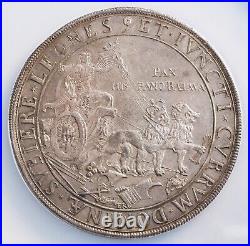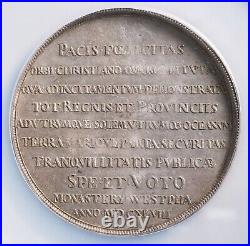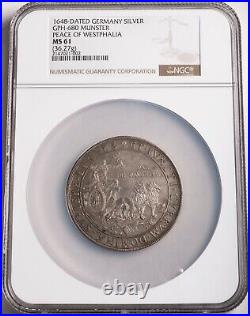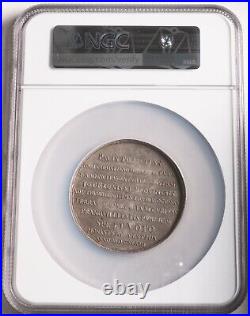1648, Germany, Munster. Silver Peace of Westphalia Showthaler Medal. NGC MS61





Silver "Peace of Westphalia" Showthaler Medal. Mint Year: 1648 Medallist: Egelbert Ketteler Denomination: Showthaler / Medal Condition. Certified and graded by NGC as MS-61! Reference: Pax 96, Goppel 680, Van Loon p.
Very rare as a problem-free mint state medal! Weight: 36.34gm Diameter: 59mm Material: Silver.
Obverse: The goddess Pax (personification of Peace), holding reins, winged caduceus, and cornucopia, driving chariot pulled by two crowned lions (" Spain and the Netherlands ") right, one holding bundle of arrows in raised forepaw, the other holding a scepter; around, military and musical instruments cast aside. Legend: (rose) ET IVNCTI CVRRVM DOMINAE SVBIERE LEONES / PAX / HIS - PANO. Alas, the lions joined together have come under the Lord's chariot.
Reverse: Legend in 10 lines. The happiness of peace unto the Christian world, however devised or accomplished by such kingdoms and provinces, either alone or by ocean, land, or sea, is the security of public harmony, for which we hope and vow here in the monastery of Westphalia in the year 1648. The Peace of Westphalia German. Was a series of peace treaties signed between May and October 1648 in the Westphalian cities of Osnabrück and Münster, effectively ending the European wars of religion. The Treaties of Westphalia brought to a close a tumultuous period of European history which saw the deaths of approximately eight million people.
The peace negotiations involved a total of 109 delegations representing European powers, including Holy Roman Emperor Ferdinand III, Philip IV of Spain, the Kingdom of France, Cristina of the Swedish Empire, the Dutch Republic, the Princes of the Holy Roman Empire, and sovereigns of the free imperial cities. Thousands of diplomats and support staff attended these conferences. The Peace of Münster together with the Treaty of Münster between the Holy Roman Emperor, France and their allies and the Treaty of Osnabrück involving the Holy Roman Empire, Sweden and their allies collectively formed the Peace of Westphalia. The Peace of Westphalia established the precedent of peaces established by diplomatic congress, and a new system of political order in central Europe, later called Westphalian sovereignty, based upon the concept of co-existing sovereign states. Inter-state aggression was to be held in check by a balance of power.
A norm was established against interference in another state's domestic affairs. As European influence spread across the globe, these Westphalian principles, especially the concept of sovereign states, became central to international law and to the prevailing world order.
